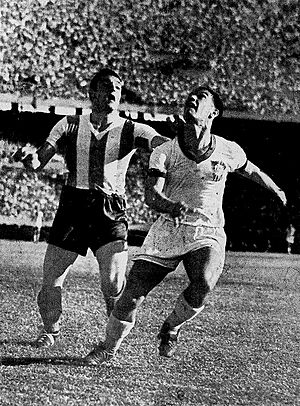Chico (footballer, born 1922) facts for kids

Juan Carlos Fonda (left) and Francisco Aramburu (right) in 1946
|
|||||||||||||||||||
| Personal information | |||||||||||||||||||
|---|---|---|---|---|---|---|---|---|---|---|---|---|---|---|---|---|---|---|---|
| Full name | Francisco Aramburu | ||||||||||||||||||
| Date of birth | 7 January 1922 | ||||||||||||||||||
| Place of birth | Uruguaiana, Brazil | ||||||||||||||||||
| Date of death | 1 October 1997 (aged 75) | ||||||||||||||||||
| Place of death | Porto Alegro, Brazil | ||||||||||||||||||
| Height | 1.68 m (5 ft 6 in) | ||||||||||||||||||
| Position(s) | Forward | ||||||||||||||||||
| Senior career* | |||||||||||||||||||
| Years | Team | Apps | (Gls) | ||||||||||||||||
| 1939–1940 | Ferro Carril | ||||||||||||||||||
| 1941–1942 | Grêmio | ||||||||||||||||||
| 1942–1954 | Vasco da Gama | ||||||||||||||||||
| 1955–1956 | Flamengo | ||||||||||||||||||
| International career | |||||||||||||||||||
| 1945–1950 | Brazil | 21 | (8) | ||||||||||||||||
|
Medal record
|
|||||||||||||||||||
| *Club domestic league appearances and goals | |||||||||||||||||||
Francisco Aramburu, known as Chico, was a famous Brazilian footballer. He was born on January 7, 1922, and passed away on October 1, 1997. Chico played as a striker, which means he was a forward player whose main job was to score goals.
Chico was known for being a very athletic and fast player. He could dribble the ball well with both feet. He also had a powerful shot, making him a dangerous player for opposing teams.
Contents
Chico's Early Football Journey
Chico started playing football in 1939 when he was 17 years old. His first team was EC Ferro Carril in his hometown. After a year, he moved to Porto Alegre. There, he joined Grêmio, a bigger club, to show off his skills.
Just one year later, in 1942, Chico received an exciting offer. He moved to Rio de Janeiro to play for CR Vasco da Gama. Rio de Janeiro was the capital of Brazil at that time.
The "Victory Express" Team
When Chico joined Vasco da Gama, a new coach named Ondino Viera also arrived. Coach Viera had won championships with other teams before. He brought new ideas and tactics to Vasco da Gama.
Another important person who joined the club was Mário Américo. He was a former boxer and became the team's physiotherapist. He later became very famous for working with the Brazil national team in many World Cups.
By 1945, Coach Viera had built a very strong team. Vasco da Gama won the state championship, called the Campeonato Carioca, without losing a single game! This amazing team was nicknamed the Expresso da Vitória, which means "Victory Express". They were known by this name from 1945 to 1952.
The "Victory Express" had a fantastic attack. Chico played on the left wing. He played alongside other great players like Ademir de Menezes, Lelé, Isaías, and Jair da Rosa Pinto. Because of his great performances, Chico was soon considered for the Brazil national team.
Playing for Brazil
Chico made his first appearance for the Brazil national team in December 1945. He played against Argentina in a series of matches called the Copa Roca. Brazil lost the first game 3-4.
However, a few days later, Brazil played Argentina again at Vasco's stadium, Estádio São Januário. Brazil won this game 6-2, which was their biggest victory against their rivals at the time. Chico scored one of the goals in this important match. Brazil then won the deciding game 3-1 to secure the trophy.
The 1950 FIFA World Cup
Chico was a key player for Brazil in the 1950 FIFA World Cup, which was held in Brazil. He played in four games during the tournament and scored four goals.
One of the most famous games he played in was against Uruguay. Brazil was expected to win the World Cup, but they lost this final match. This unexpected loss is known as the "Maracanazo". It meant Brazil did not win the 1950 World Cup.
Even though Brazil lost, Chico was one of the top goal scorers in the tournament. He won a Bronze Shoe award, sharing it with Alcides Ghiggia, Telmo Zarra, and Estanislau Basora.
Achievements and Awards
Chico had a very successful career, winning many titles with his clubs and earning individual honors.
- South American Club Championship: 1948 (with Vasco da Gama)
- Campeonato Carioca (Rio de Janeiro State Championship): 1945, 1947, 1949, 1950, 1952 (all with Vasco da Gama)
- IFFHS Brazilian Player of the 20th Century: 15th place
- IFFHS South American Player of the 20th Century: 19th place
- FIFA World Cup Bronze Boot: 1950
- Brazilian Football Museum Hall of Fame
See also
 In Spanish: Chico (futbolista) para niños
In Spanish: Chico (futbolista) para niños

